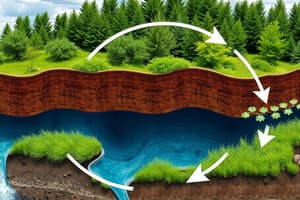Podcast
Questions and Answers
Which of the following reservoirs is considered the largest storage of carbon in the slow carbon cycle?
Which of the following reservoirs is considered the largest storage of carbon in the slow carbon cycle?
- Atmosphere
- Rocks and sediments (correct)
- Biosphere
- Ocean
The fast carbon cycle operates on a timescale of millions of years, similar to the slow carbon cycle.
The fast carbon cycle operates on a timescale of millions of years, similar to the slow carbon cycle.
False (B)
Briefly explain how volcanic activity plays a role in the slow carbon cycle.
Briefly explain how volcanic activity plays a role in the slow carbon cycle.
Volcanic activity releases carbon dioxide ($CO_2$) from the Earth's interior into the atmosphere, contributing to the long-term carbon cycle by returning carbon stored in rocks back to the atmosphere. This is a part of the geological timescale carbon exchange.
The process of converting atmospheric nitrogen ($N_2$) into ammonia ($NH_3$) or ammonium ($NH_4^+$) that can be used by plants is known as ______.
The process of converting atmospheric nitrogen ($N_2$) into ammonia ($NH_3$) or ammonium ($NH_4^+$) that can be used by plants is known as ______.
Match the carbon cycle processes with their descriptions:
Match the carbon cycle processes with their descriptions:
Which of these human activities has the most significant impact on increasing atmospheric carbon dioxide concentrations?
Which of these human activities has the most significant impact on increasing atmospheric carbon dioxide concentrations?
Denitrification is a process in the nitrogen cycle that increases the availability of nitrogen in soils for plant uptake.
Denitrification is a process in the nitrogen cycle that increases the availability of nitrogen in soils for plant uptake.
Explain the role of phytoplankton in the biological carbon pump.
Explain the role of phytoplankton in the biological carbon pump.
The process where ammonium ($NH_4^+$) is converted into nitrites ($NO_2^-$) and then nitrates ($NO_3^-$) by bacteria is called ______.
The process where ammonium ($NH_4^+$) is converted into nitrites ($NO_2^-$) and then nitrates ($NO_3^-$) by bacteria is called ______.
Limestone and chalk cliffs are significant examples of carbon sinks formed through which process?
Limestone and chalk cliffs are significant examples of carbon sinks formed through which process?
Industrialization has significantly slowed down the rate of carbon transfer in the fast carbon cycle.
Industrialization has significantly slowed down the rate of carbon transfer in the fast carbon cycle.
What is 'Terra Preta' and why is it significant in the context of nutrient cycles?
What is 'Terra Preta' and why is it significant in the context of nutrient cycles?
The release of nitrogen compounds like ammonia ($NH_3$) into the atmosphere from animal waste and fertilizers is known as ______.
The release of nitrogen compounds like ammonia ($NH_3$) into the atmosphere from animal waste and fertilizers is known as ______.
Which of the following is a direct consequence of increased atmospheric carbon dioxide levels?
Which of the following is a direct consequence of increased atmospheric carbon dioxide levels?
Deforestation generally leads to an increase in nutrient retention within a watershed.
Deforestation generally leads to an increase in nutrient retention within a watershed.
Describe the difference in timescales between the slow and fast carbon cycles and give an example of a process for each.
Describe the difference in timescales between the slow and fast carbon cycles and give an example of a process for each.
In the context of nutrient cycling, 'fixers' are organisms primarily involved in ______ fixation.
In the context of nutrient cycling, 'fixers' are organisms primarily involved in ______ fixation.
According to the global carbon cycle diagram, which of the following reservoirs contains the largest amount of dissolved inorganic carbon?
According to the global carbon cycle diagram, which of the following reservoirs contains the largest amount of dissolved inorganic carbon?
The cumulative $CO_2$ emissions from land-use change are included in the data presented in the 'Cumulative $CO_2$ emissions' graph.
The cumulative $CO_2$ emissions from land-use change are included in the data presented in the 'Cumulative $CO_2$ emissions' graph.
Match the nitrogen cycle processes with the corresponding numbered steps from the diagram:
Match the nitrogen cycle processes with the corresponding numbered steps from the diagram:
Flashcards
Slow Carbon Cycle
Slow Carbon Cycle
Movement of carbon between rocks, soil, ocean, and atmosphere over 100-200 million years.
Fast Carbon Cycle
Fast Carbon Cycle
Carbon transfered by the biosphere through photosynthesis, respiration, and decomposition.
Biological Carbon Pump
Biological Carbon Pump
Phytoplankton use photosynthesis to produce organic matter.
Atmospheric Nitrogen (N2)
Atmospheric Nitrogen (N2)
Signup and view all the flashcards
Nitrogen Fixation
Nitrogen Fixation
Signup and view all the flashcards
Ammonia Assimilation
Ammonia Assimilation
Signup and view all the flashcards
Nitrification
Nitrification
Signup and view all the flashcards
Assimilatory Nitrate Reduction
Assimilatory Nitrate Reduction
Signup and view all the flashcards
Ammonification
Ammonification
Signup and view all the flashcards
Denitrification
Denitrification
Signup and view all the flashcards
Deforestation
Deforestation
Signup and view all the flashcards
Terra Preta
Terra Preta
Signup and view all the flashcards
Study Notes
Learning Outcomes
- Understand general nutrient cycling models.
- Examine slow and fast carbon cycle differences.
- Recognize climate change's impact on the global carbon cycle.
- Describe the nitrogen cycle.
- Be aware of cascading human activity impacts on nutrient cycles.
General Model of Nutrient Cycling
- Solar heating impacts the atmosphere, cryosphere, biosphere, hydrosphere, and lithosphere.
- The atmosphere contains nitrogen, oxygen, argon, water vapor, carbon dioxide, and other greenhouse gases.
- The cryosphere includes valley glaciers, snow cover, continental glaciers, and sea ice.
- The biosphere consists of lakes, rivers and human activities.
- The hydrosphere is the ocean.
- The lithosphere includes volcanism.
- Living entities such as consumers, primary producers, decomposers and fixers are factors in the nutrient cycle.
- Primary producers decompose into dead organic matter.
Carbon
- Limestone is an ancient carbon sink formed from fossil exoskeletons of corals about 340 million years ago.
- Carbon can be found in; Chalk Cliffs, Limestone Caves, Oil and Gas, and Coal.
The Slow Carbon Cycle
- Carbon takes 100-200 million years to move in rocks, soil, ocean, and atmosphere via chemical reactions and tectonic activity.
- Rain releases calcium and other ions through carbonic acid weathering.
- Calcium combines with bicarbonate ions to make calcium carbonate, transporting it to oceans.
- CO2 is converted to dissolved HCO3- by Ca-Mg silicate weathering.
- CO2 comes from sedimentary organic C weathering.
- CO2 and CH4 result from metamorphism and deep diagenesis.
- CaCO3 and organic C undergo subduction.
The Fast Carbon Cycle
- Annually, 10-100 million metric tons of carbon move through the slow carbon cycle.
- The biosphere drives the fast carbon cycle via photosynthesis, respiration, and decomposition.
- The fast carbon cycle moves around 1000 times more carbon than the slow carbon cycle annually.
- Industrialization began in the late 18th century, causing massive population growth.
- Human carbon emissions are around 10^15 grams (1000 million metric tons).
- The fast carbon cycle moves 10^16 - 10^17 grams of carbon annually.
The Global Carbon Cycle
- A schematic representation of anthropogenic global carbon cycle perturbations (2012-2021) reveals a small atmospheric CO2 growth rate uncertainty (±0.02 GtC yr−1).
- Fossil CO2 emissions increase.
- Land uptake increases.
- Land-use change increases.
- Ocean uptake increases.
- There is ± Atmospheric increase.
- There is a level of budget imbalance.
Nitrogen Cycle
- Atmospheric nitrogen undergoes fixation.
- Nitrogen moves between atmospheric fixation, volatilization, animal manure and biological fixation.
- Plants uptake and harvest fertilizer, whether commercial or those from legume.
- Plant residues breakdown, as does organic matter.
- Ammonuim turns to nitrate.
- Nitrate experiences leaching loss.
Nitrogen Processes
- Nitrogen Fixation: N₂ reacts to form any N-compound.
- Ammonia Assimilation: NH₃ and NH₄⁺ are taken up by plants.
- Nitrification: NH₃ and NH₄⁺ oxidize into NO₂⁻ and NO₃⁻ by organisms.
- Assimilatory Nitrate Reduction: NO₂⁻ and NO₃⁻ are absorbed by organisms.
- Ammonification: Organic N-compounds break down into NH₃ and NH₄⁺.
- Denitrification: Denitrifying bacteria reduce NO₂⁻ and NO₃⁻ to N₂ and N₂O.
Terra Preta
- Terra Preta is fertile, man-made Amazonian soil.
- Over hundreds of years, people mixed charcoal, manure, pottery, and leaves to make compost in nutrient-poor soil.
- Soil microbes take up minerals, which cycle around the soil community and provide major nutrient storage in the Amazon rain forest.
Conclusion
- Life is organized into ecological communities on Earth.
- It acts as a chemical engine.
- It cycles elements, stores carbon in rocks, and maintains an even environment.
- This creates unique conditions on the Earth's surface.
Studying That Suits You
Use AI to generate personalized quizzes and flashcards to suit your learning preferences.




